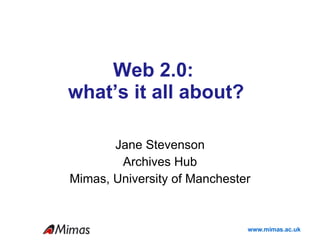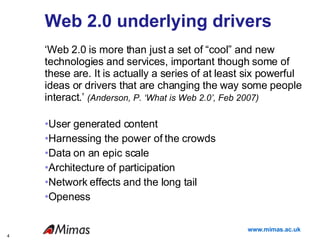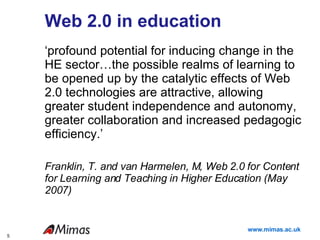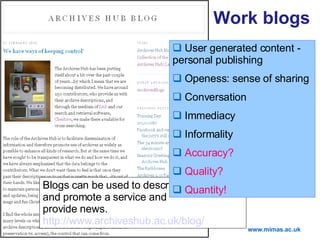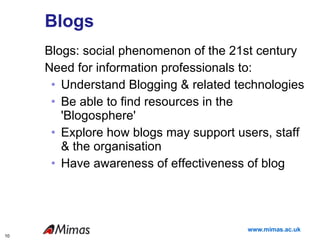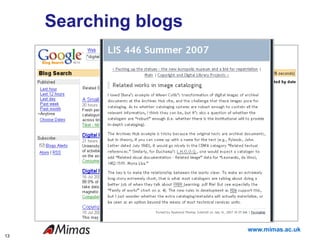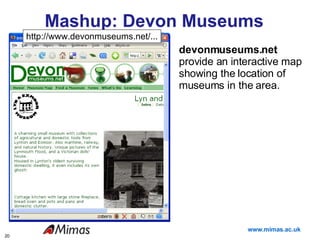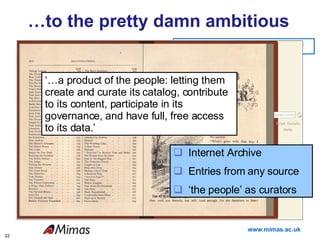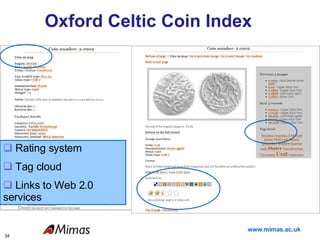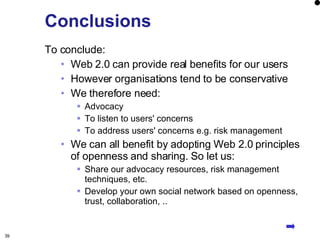Web2 Oct08
- 1. Web 2.0: what’s it all about? Jane Stevenson Archives Hub Mimas, University of Manchester
- 2. Web 2.0 Technologies and tools RSS Mashups Blogs Social bookmarking Wikis Social networks Mindset Openess Experimentation Trust Participation There is no authoritative definition
- 3. Web 2.0 (based on O’Reilly ) An attitude (not a technology) Web 2.0 Perpetual beta Rich user experience Trust your users Small pieces loosely joined The right to remix User control of own data Play The web as a platform The long tail
- 4. Web 2.0 underlying drivers ‘ Web 2.0 is more than just a set of “cool” and new technologies and services, important though some of these are. It is actually a series of at least six powerful ideas or drivers that are changing the way some people interact.’ (Anderson, P. ‘What is Web 2.0’, Feb 2007) User generated content Harnessing the power of the crowds Data on an epic scale Architecture of participation Network effects and the long tail Openess
- 5. Web 2.0 in education ‘ profound potential for inducing change in the HE sector…the possible realms of learning to be opened up by the catalytic effects of Web 2.0 technologies are attractive, allowing greater student independence and autonomy, greater collaboration and increased pedagogic efficiency.’ Franklin, T. and van Harmelen, M, Web 2.0 for Content for Learning and Teaching in Higher Education (May 2007)
- 6. Some Web 2.0 tools Blogs Wikis Sharing content Mashups Social networks Tagging
- 8. Educational blogs http://piclib.nhm.ac.uk/antarctica/ This blog tells what it's like spending the winter in Antarctica conserving artefacts from the explorer's hut left behind by Ernest Shackleton in 1908.
- 9. Work blogs Blogs can be used to describe and promote a service and provide news. http://www.archiveshub.ac.uk/blog/ User generated content - personal publishing Openess: sense of sharing Conversation Immediacy Informality Accuracy? Quality? Quantity!
- 10. Blogs Blogs: social phenomenon of the 21st century Need for information professionals to: Understand Blogging & related technologies Be able to find resources in the 'Blogosphere' Explore how blogs may support users, staff & the organisation Have awareness of effectiveness of blog
- 11. Reading blogs RSS: one of the most significant advances in the architecture of the Web rather than just linking to a page can subscribe to it Permalinks important to be able to identify each blog entry Allows for ‘conversation’
- 12. Technorati Currently tracking 93.8 million blogs and over 250 million pieces of tagged social media (user-generated content) July 2007
- 13. Searching blogs
- 14. Blogs Often interconnected (discuss other blog postings) Many people use Technorati and Google blog search Bang up to date Range in quality of content enormously! Danger of overload
- 15. Wikis Collaborative authoring tools Can use wikis for: Dissemination Collaborative papers Note-taking at events Social discussions at events Follow-up Level of use? Trust Web 2.0
- 16. Wikipedia User generated content Power of crowds Sharing Huge scale Current Trust, accuracy?
- 17. Wikipedia Wikipedia entry for the Society of Archivists: Easy to create Provides high-profile information (Google-friendly) Allows community to enhance & develop content Created in 2004 (and improved since) Opportunities http://en.wikipedia.org/wiki/Society_of_Archivists
- 18. Sharing - Flickr User generated content Share photos from conferences and other events Community-building Openess: sense of sharing Copyright? Searching issues
- 19. Sharing – del.icio.us Manage your bookmarks Make connections Build reading lists Allow lists of bookmarks to be repurposed Find good material Rely on tagging Organisation
- 20. Mashup: Devon Museums devonmuseums.net provide an interactive map showing the location of museums in the area. http://www.devonmuseums.net/...
- 21. Mashups: google maps www.archiveshub.ac.uk/inst/contmap.html Sharing Right to remix Rich user experience IPR? Time/use http://www.housingmaps.com/
- 22. Social networks Engage with potential users of services through social networks APIs enable them to develop their own applications Can (i) develop application (ii) enable others to do so Set up own social groups
- 23. Examples http://www.leodis.org Search for ‘bawn lane’ – comment added to photograph http://www.academia.edu/ A tree of academics around the world ( http://manchester.academia.edu/JaneStevenson ) Building Applications: Facebook http://ukwebfocus.wordpress.com/2008/08/13/revisiting-development-of-facebook-applications/
- 26. Google Videos & YouTube Google and the US National Archives have entered into a partnership to make historic footage from the National Archives collection available on the Google Video server http://video.google.com/nara.html
- 27. Aggregation of data: personalised home pages Bringing information together in your own way
- 28. The need to let go! Information professionals: Think they know better than the user Think that users should be forced to learn formal search techniques because this is good for them Don't want the users to search for themselves (cf folksonomies) because they won't get it right. Want services to be perfect before they release them to users.
- 29. Deployment Strategies Address organisation objectives Low-hanging fruits Encourage the enthusiasts Staff training & development Address areas you feel comfortable with Risk management strategy… Deployment Challenges
- 30. Risk Management Be realistic, recognise limitations Use of well-established services : Google & del.icio.us are well-established and have financial security Use and build on what others have done Notification : warnings that services could be lost Use in non-mission critical areas Deployment Strategy
- 31. Web 2.0 in archives Engaging with users Taking advantage of users’ knowledge New ways to communicate Encourage collaboration Raise the profile of archives Provide instant news and comment Use in teaching and learning environments Help keep archivists up-to-date with developments and innovations
- 32. From the very ambitious… Crowdsourcing Collaborative Trusting Creative commons
- 33. … to the pretty damn ambitious http://demo.openlibrary.org/ Internet Archive Entries from any source ‘ the people’ as curators ‘… a product of the people: letting them create and curate its catalog, contribute to its content, participate in its governance, and have full, free access to its data.’
- 34. Oxford Celtic Coin Index View location on map Add a comment Rating system Tag cloud Links to Web 2.0 services
- 35. Harnessing the power of crowds Success increasingly requires service providers to embrace the power of the web to harness collective intelligence: Google: link structure eBay's: collective activity of all its users Amazon: made a science of user engagement and uses user activity to produce better search results
- 36. Harnessing the power of crowds Flickr, del.icio.us: use folksonomies - collaborative categorization of sites using freely chosen keywords, often referred to as tags Collaborative spam-filtering products The collective attention of the blogosphere selects for value – collective intelligence
- 37. Who owns the data? “ The race is on to own certain classes of core data: location, identity, calendaring of public events, product identifiers and namespaces. In many cases, where there is significant cost to create the data, there may be … a single source for the data. In others, the winner will be the company that first reaches critical mass via user aggregation , and turns that aggregated data into a system service.” http://www.oreillynet.com : What is Web 2.0?
- 38. Control of data user concerns about privacy and their rights to their own data early web applications - copyright loosely enforced (Amazon reviews) control over data may be chief source of competitive advantage for companies - heightened attempts at control countered by ‘free data’ movement (Wikipedia, Greasemonkey, etc.)
- 39. Conclusions To conclude: Web 2.0 can provide real benefits for our users However organisations tend to be conservative We therefore need: Advocacy To listen to users' concerns To address users' concerns e.g. risk management We can all benefit by adopting Web 2.0 principles of openness and sharing. So let us: Share our advocacy resources, risk management techniques, etc. Develop your own social network based on openness, trust, collaboration, .. Conclusions
